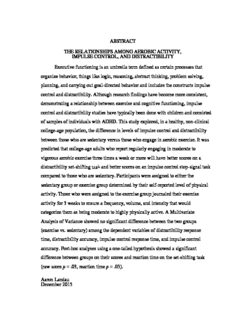
the relationships among aerobic activity, impulse control, and distractibility PDF
Preview the relationships among aerobic activity, impulse control, and distractibility
ABSTRACT THE RELATIONSHIPS AMONG AEROBIC ACTIVITY, IMPULSE CONTROL, AND DISTRACTIBILITY Executive functioning is an umbrella term defined as certain processes that organize behavior, things like logic, reasoning, abstract thinking, problem solving, planning, and carrying out goal-directed behavior and includes the constructs impulse control and distractibility. Although research findings have become more consistent, demonstrating a relationship between exercise and cognitive functioning, impulse control and distractibility studies have typically been done with children and consisted of samples of individuals with ADHD. This study explored, in a healthy, non-clinical college-age population, the difference in levels of impulse control and distractibility between those who are sedentary versus those who engage in aerobic exercise. It was predicted that college-age adults who report regularly engaging in moderate to vigorous aerobic exercise three times a week or more will have better scores on a distractibility set-shifting task and better scores on an impulse control stop-signal task compared to those who are sedentary. Participants were assigned to either the sedentary group or exercise group determined by their self-reported level of physical activity. Those who were assigned to the exercise group journaled their exercise activity for 3 weeks to ensure a frequency, volume, and intensity that would categorize them as being moderate to highly physically active. A Multivariate Analysis of Variance showed no significant difference between the two groups (exercise vs. sedentary) among the dependent variables of distractibility response time, distractibility accuracy, impulse control response time, and impulse control accuracy. Post-hoc analyses using a one-tailed hypothesis showed a significant difference between groups on their scores and reaction time on the set-shifting task (raw score p = .03, reaction time p = .03). Aaron Landau December 2015 THE RELATIONSHIPS AMONG AEROBIC ACTIVITY, IMPULSE CONTROL, AND DISTRACTIBILITY by Aaron Landau A thesis submitted in partial fulfillment of the requirements for the degree of Master of Arts in Kinesiology in the College of Health and Human Services California State University, Fresno December 2015 APPROVED For the Department of Kinesiology: We, the undersigned, certify that the thesis of the following student meets the required standards of scholarship, format, and style of the university and the student's graduate degree program for the awarding of the master's degree. Aaron Landau Thesis Author Dawn Lewis (Chair) Kinesiology Catherine Jackson Kinesiology Karl Oswald Psychology For the University Graduate Committee: Dean, Division of Graduate Studies AUTHORIZATION FOR REPRODUCTION OF MASTER’S THESIS X I grant permission for the reproduction of this thesis in part or in its entirety without further authorization from me, on the condition that the person or agency requesting reproduction absorbs the cost and provides proper acknowledgment of authorship. Permission to reproduce this thesis in part or in its entirety must be obtained from me. Signature of thesis author: ACKNOWLEDGMENTS I would not have been able to complete this thesis without the help and support of my committee members, friends, and family. First, I would like to thank my committee chair, Dr. Dawn Lewis, for all her patience while working with me. My writing was able to develop and improve considerably because of all the care she gave in editing each draft so thoroughly. She also spent a substantial amount of time with me in weekly meetings which I greatly appreciate. Additionally, I would like to thank my other two committee members, Dr. Catherine Jackson and Dr. Karl Oswald, for the guidance they provided and the time they spent helping me with this thesis. Also, I need to thank Alexi and Zack for all their support through this process. All the fun times we had together definitely eased a lot of stress. Lastly, I want thank my mother and my sister for all their support and love. TABLE OF CONTENTS Page LIST OF TABLES ................................................................................................. vii LIST OF FIGURES ............................................................................................... viii CHAPTER 1: INTRODUCTION ............................................................................ 1 Research Questions ........................................................................................... 4 Research Hypotheses ........................................................................................ 5 Significance ....................................................................................................... 5 Delimitations ..................................................................................................... 6 Limitations ........................................................................................................ 7 Definitions of Terms ......................................................................................... 8 CHAPTER 2: LITERATURE REVIEW ............................................................... 13 CHAPTER 3: METHOD ........................................................................................ 17 Research Design .............................................................................................. 17 Participant Description .................................................................................... 17 Instruments ...................................................................................................... 19 Procedure ......................................................................................................... 25 Analysis ........................................................................................................... 28 CHAPTER 4: RESULTS ....................................................................................... 29 Post-Hoc Analyses .......................................................................................... 34 CHAPTER 5: DISCUSSION ................................................................................. 35 Future Research ............................................................................................... 38 REFERENCES ....................................................................................................... 40 APPENDICES ........................................................................................................ 48 APPENDIX A: IRB APPROVAL ......................................................................... 49 vi vi Page APPENDIX B: INFORMED CONSENT .............................................................. 51 APPENDIX C: DEMOGRAPHICS QUESTIONNAIRE ...................................... 54 APPENDIX D: MENTAL HEALTH QUESTIONNAIRE ................................... 56 APPENDIX E: INTERNATIONAL PHYSICAL ACTIVITY QUESTIONNAIRE (IPAQ) ........................................................................ 58 APPENDIX F: IPAQ SCORING PROTOCOL ..................................................... 65 APPENDIX G: JOURNAL .................................................................................... 83 APPENDIX H: BORG-RPE SCALE ..................................................................... 86 APPENDIX I: IMPULSE CONTROL INSTRUCTIONS ..................................... 88 APPENDIX J: SET-SHIFTING TASK INSTRUCTIONS ................................... 91 APPENDIX K: POST-TEST QUESTIONNAIRE ................................................ 94 LIST OF TABLES Page Table 1 Demographic Information of Participants ............................................... 17 Table 2 Descriptive Statistics of Interest, Effort, and Attention on Cognitive Tasks of Sedentary vs Exercise Group ..................................................... 29 Table 3 Descriptive Statistics of the Cognitive Task Scores of Sedentary vs Exercise Group ........................................................................................ 30 Table 4 MANOVA Tests of Between-Subjects Effects on the Impulse Control Task .......................................................................................................... 31 Table 5 MANOVA Tests of Between-Subjects Effects on the Distractibility Task .......................................................................................................... 33 LIST OF FIGURES Page Figure 1. Sample calculation of IPAQ long form scoring protocol (IPAQ, 2005). ...................................................................................................... 19 Figure 2. IPAQ categorization of low, moderate, and high physical activity (IPAQ, 2005). .......................................................................................... 21 Figure 3. Decision-tree for participant placement ................................................. 27 Figure 4. Correlation scatterplot of performance on the impulse control to distractibility task measured by the total number of correct trials. ......... 33
Description: